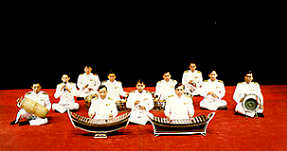
Contex: entertrainment
Ensemble: all standard ensembles
 << Listen to Sepha Mahori
<< Listen to Sepha Mahori
|
Sepha mahori
This is the repertoire that is well known to the public and to amateur
musicians. It includes the thaw form and instrument solos. Traditionally
compositions in this category were performed in a set concert structure. The purpose of
music in the seephaa mahori category is entertainment, and all the pieces which
are most likely to be known to the general populace through public school or other
introductions to music, or through amateur music-making, are in this category. All
pleeng thaw, the expanding-contracting tripartite musical form so popular in the last
one hundred years, are in this category. The popularity of composition in this repertoire
may well be due to their purely musical nature, that is, they are tied neither to
theater nor to special performance contexts such as cremation ceremonies or royal
processions. Transmission of the songs is not restricted. Students may learn these
compositions and enjoy them. And the compositions may be performed either with or without
a vocalist, except in a occasional cases. Thai musicians suggest that many of the songs
are well known because they are inherently beautiful and, when per formed as vocal music,
often have picturesque, pleasing lyrics-- for example Khameen Saj Yok, a
particularly well-known melody, the words of which describe the beauty of natural scenes
Both seepha
and mahori are ensemble types and represent two historical strands, which have
merged. The seepha uses piphat instruments to accompany chanted epics.
Differences
between the style of songs are derived from each, the mahori songs being soft,
slow, refined, gentle, and appropriate to their original palace context, while the seephaa
songs are aggressive, strong, and quick; they were originally performed both in and
outside the palaces. However, the songs in the present-day seephaa mahori
category may be performed upon either piphat or mahori, or khryang
sai ensembles and mixed ensembles. The category is believed to have originated in the
era of Rama IV (mid-19th Century), though many of the songs were written somewhat later;
it is possible that the full fusion of seephaa and mahori influences
occurred after the change of government in 1932.
Back |